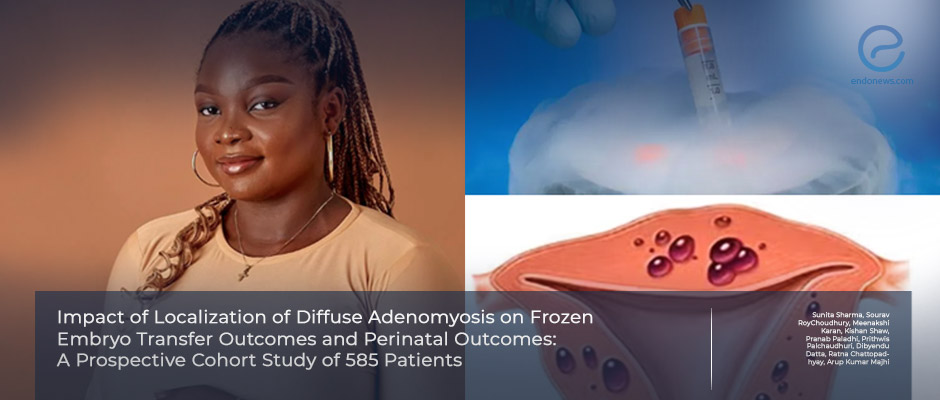Lesion Localization Determines IVF Outcomes in Adenomyosis
Oct 22, 2025
Junctional Zone Adenomyosis Lowers Live Birth Rates.
Key Points
Highlights:
- The localization of diffuse adenomyosis lesions significantly influences reproductive outcomes after frozen embryo transfer (FET).
- Junctional zone involvement is associated with poorer implantation and live-birth outcomes than outer myometrial disease.
Importance:
- Determining the exact site of adenomyotic lesions before assisted reproductive treatment enables accurate counseling, risk stratification, and individualized management.
- Incorporating lesion mapping into routine pre-ART assessment may ultimately improve pregnancy and live-birth rates in affected women.
What’s done here:
- A prospective cohort study of 585 infertile women undergoing their first FET cycle was conducted.
- Among 368 women with diffuse adenomyosis, lesions were localized to the outer myometrium (n = 167) or junctional zone (n = 201) and compared with 217 controls with male-factor infertility.
- Adenomyosis was diagnosed by transvaginal ultrasound.
Key results:
- The rates of overall pregnancy, biochemical and clinical pregnancy rates were comparable betwee adenomyosis andcontrol groups.
- Women with adenomyosis had a higher miscarriage rate (22.0% vs 9.2%) and a lower live-birth rate (20.6% vs 29.9%) than controls.
- Junctional zone adenomyosis yielded lower positive pregnancy (26%), clinical pregnancy (23%), and live-birth (16%) rates than outer-myometrium adenomyosis (48%, 43%, and 26%, respectively).
- Miscarriage and biochemical pregnancy rates did not differ between junctional zone and outer-myometrial disease.
- Pregnancy complications such as gestational hypertension, IUGR, and preterm labor were significantly more frequent in adenomyosis patients than in controls.
Limitations:
- Observational prospective design limits causal inference; some participants had co-existing endometriosis, which may confound outcomes; sample size was modest, particularly for subgroup analyses of obstetric complications.
From the Editor-in-Chief – EndoNews
"This study provides compelling evidence that not all diffuse adenomyosis is biologically equivalent—its anatomic localization profoundly influences reproductive outcomes after assisted reproduction. The markedly poorer live-birth rates observed with junctional zone involvement reinforce the central role of the junctional zone in uterine contractility, implantation dynamics, and endometrial receptivity.
Clinically, these findings highlight the necessity of systematic lesion mapping by high-resolution ultrasound or MRI before embryo transfer. Incorporating lesion localization into ART planning can refine patient counseling, treatment stratification, and prognostic accuracy.
Importantly, the study reclassifies adenomyosis from a uniform diagnostic label into a spatially defined, functionally heterogeneous disorder—a shift that will inform both future research and individualized reproductive care."
Lay Summary
The localization of anenomyosis can affect the outcome of assisted reproductive techniques, according to a new study published in the scientific journal Gynecologic and Obstetric Investigation. It is, therefore, paramount to evaluate and localize adenomyotic lesions before starting assisted reproduction. This can help in effective counseling and personalized treatment approaches to ensure the best reproductive outcomes are reached.
To assess the effect of the localization of diffuse adenomyosis on reproductive outcomes following frozen embryo transfer, a team of researchers led by Dr. Arup Kumar Majhi from the Department of Obstetrics and Gynecology at Santiniketan Medical College in Bolpur, India, conducted a prospective cohort study in 585 women with infertility who underwent their first frozen embryo transfer from January 2019 to December 2022.
Of these, 368 had diffuse adenomyosis. Less than half (45%) of these had diffuse adenomyosis of the outer myometrium, while 55% had diffuse adenomyosis of the junctional zone. A total of 217 women undergoing assisted reproduction due to male infertility were used as controls.
The results showed that women with diffuse adenomyosis had similar rates of pregnancy, biochemical pregnancy (pregnancy that lasts only up to 5 weeks), and clinical pregnancy (pregnancy where signs of a fetus can be seen or heard) compared to women without adenomyosis.
However, these women had higher rates of miscarriage and lower rates of live births. Women with diffuse adenomyosis affecting the junctional zone had significantly lower positive pregnancy and clinical pregnancy as well as live birth rates compared to women with adenomyosis of the outer myometrium. However, they had comparable biochemical pregnancy and miscarriage rates.
The rates of pregnancy complications were also similar between patients with adenomyosis affecting different areas. However, the incidence of pregnancy complications like gestational hypertension (high blood pressure due to pregnancy), intrauterine growth restriction, and premature birth was significantly higher in patients with adenomyosis compared to the controls.
“Pregnant women with adenomyosis should be managed carefully as high-risk pregnancies, considering the possible serious obstetric complications,” the authors of the study concluded.
Research Source: https://pubmed.ncbi.nlm.nih.gov/40435981/
adenomyosis assisted reproduction frozen embryo pregnancy

